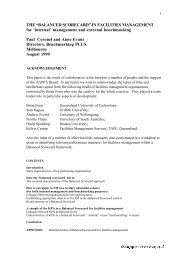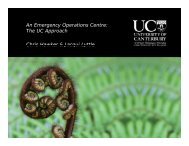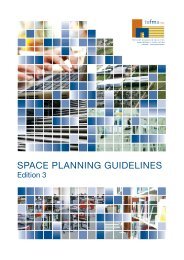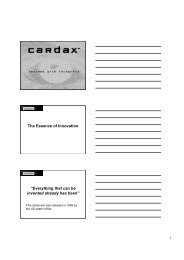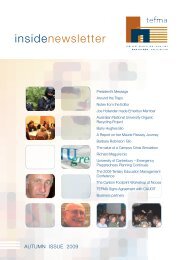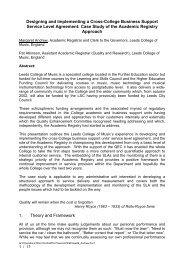New Zealand Association of Private Education Providers - Tertiary ...
New Zealand Association of Private Education Providers - Tertiary ...
New Zealand Association of Private Education Providers - Tertiary ...
Create successful ePaper yourself
Turn your PDF publications into a flip-book with our unique Google optimized e-Paper software.
Quality Management Systems And Their Impact<br />
On A <strong>Tertiary</strong> Institution<br />
Developing excellence by collegial growth, customer satisfaction and a value driven<br />
quality culture<br />
Bruce Knox, Executive Director, Bible College <strong>of</strong> <strong>New</strong> <strong>Zealand</strong> Inc., Auckland<br />
Abstract<br />
This workshop is aimed to provide each manager or supervisor within a tertiary<br />
institution with the skills and confidence needed to most effectively develop a quality<br />
management system. The workshop itself shares the journey and experience <strong>of</strong> one<br />
provider in developing its custom-made quality management overview. The session<br />
will be interactive and will explain the four stages <strong>of</strong> quality management<br />
development.<br />
Why quality management<br />
How to develop a quality management system (the involvement <strong>of</strong> staff)<br />
How to monitor quality management.<br />
How to validate or audit quality management.<br />
Involvement in the workshop will provide the participant with sample pages and<br />
templates, which could be used or modified within any institution. By the end <strong>of</strong> the<br />
workshop the participant will have gained the confidence to proceed with the<br />
customised development <strong>of</strong> a quality management system that will reflect the needs<br />
<strong>of</strong> their particular section, department, or institution.<br />
Overview<br />
This workshop answers the following questions and statements put forward. It will<br />
provide an interactive experience specifically focused for those at the start <strong>of</strong> the<br />
Quality journey. It assumes a provider does not already have a quality system in<br />
place and will provide a step by step process develop such a system by addressing A<br />
to D below, from one provider’s point <strong>of</strong> view.<br />
A) Why is quality management important<br />
Who in the organisation "does quality"<br />
(See sample page 1 available to workshop participants)<br />
B) How do you develop a QMS system using staff-based workshops<br />
How do you achieve organisational ownership as a key outcome<br />
(See sample pages 2 – 8 available to workshop participants)<br />
C) How do you monitor a QMS by using reporting cycles<br />
(See sample pages 9 – 21 available to workshop participants)<br />
D) How does QMS reporting lead to peer review and external audits<br />
What was BCNZ's experience in preparing for peer review<br />
What suggestions in preparing for audit can be made<br />
(See sample pages 22 – 34 available to workshop participants)
Why Quality Management<br />
Fad, Common Sense or A Key to the Future<br />
The reason why BCNZ as a tertiary theological provider got involved with the quality<br />
journey was because <strong>of</strong> the external changes in the educational landscape.<br />
Fundamentally, BCNZ found the definition <strong>of</strong> Quality meaning, "Doing it right the<br />
first time" to be extremely relevant. In the new environment <strong>of</strong> tertiary education it<br />
was imperative for a provider to be at the forefront <strong>of</strong> quality delivery.<br />
It was the objective <strong>of</strong> Bible College <strong>of</strong> <strong>New</strong> <strong>Zealand</strong> Inc. (BCNZ) to be a quality<br />
provider <strong>of</strong> theological education thus meeting the learning needs <strong>of</strong> each<br />
stakeholder grouping. Since BCNZ’s inception in 1922, there had been a significant<br />
increase in the number <strong>of</strong> providers in the <strong>New</strong> <strong>Zealand</strong> Theological Sector. BCNZ<br />
was keen to retain its excellent reputation, and therefore, constantly recognised the<br />
importance <strong>of</strong> the philosophy (belief) that the provider who serves the students’<br />
learning aspirations best will grow and prosper. Accordingly, BCNZ embarked on a<br />
journey committed to developing quality systems.<br />
BCNZ knew that the term "quality" had been used and abused since it first appeared<br />
in the tertiary education lexicon during the last decade. While some viewed the<br />
implementation <strong>of</strong> quality systems as a fad and inappropriate in tertiary education,<br />
the journey undertaken at BCNZ came from the belief that an effective quality system<br />
was not only a key to the future <strong>of</strong> Bible College <strong>of</strong> <strong>New</strong> <strong>Zealand</strong>, but was really just<br />
good old fashioned common sense. It was the philosophy that BCNZ's founders<br />
Kemp, Rolls and Laidlaw believed in and were totally committed to.<br />
For our organisation to be quality assured, we agreed that each and every person at<br />
all levels within the organisation must commit to doing the job right the first time. We<br />
accepted we could not afford the cost <strong>of</strong> rework. In the educational sector this<br />
related to the area <strong>of</strong> student dissatisfaction, where "inferior workmanship" adversely<br />
affects the quality <strong>of</strong> classroom learning, student outcomes, and organisational<br />
systems. If we were to be quality assured, that required our people to be focused on<br />
quality delivery at every point.<br />
We realized each person in the organisation must know the students personally,<br />
must know what BCNZ's common goals are and what are the special needs for each<br />
individual student. Staff must be clear on the generic policies and procedures,<br />
especially those that affect their area <strong>of</strong> responsibility. Individuals must have specific<br />
quality performance goals, which they consistently own, meet or exceed.<br />
BCNZ accepted that if each person in the organisation commits to "practising<br />
quality", then collectively, as an organization, this quality would be reflected within the<br />
sector. BCNZ's commitment to quality was firstly for the sake <strong>of</strong> the students, and<br />
secondly for our organisation’s survival. We knew that if we did not deliver quality in<br />
our culture, and systems, then students within the modern era <strong>of</strong> NZ's tertiary scene<br />
would simply vote with their feet.
Hence, in today's highly competitive and global marketplace, quality has become the<br />
backbone <strong>of</strong> a successful organisation. Consumers (students) at all levels <strong>of</strong> buyingpower<br />
are smarter and more demanding. Quality literature tells us, for those who<br />
wish to maintain leadership status there is always room for products or services that<br />
take quality to new heights. BCNZ had to face this challenge. We had observed that<br />
while brand loyalty still measured strongly, today's successes are a reflection <strong>of</strong> true<br />
customer satisfaction. This, we knew, would be no different in the tertiary sector, and<br />
in particular amongst the 134 teaching sites at each level between 1988 and 1999.<br />
Choice was a reality in the tertiary theological marketplace. Quality performance was<br />
a key ingredient in a student's decision-making arsenal. We accepted that a provider<br />
not only had to be able to say they were quality assured, they must be able to prove<br />
it.<br />
What is a Quality Management System<br />
Quality, we discovered, was a derivative <strong>of</strong> the entire organisation’s commitment to<br />
developing a product, course, or service and an educational programme or course<br />
was no exception to this rule. So quality is dependent on the totality <strong>of</strong> an<br />
organisation’s efforts, and the involvement and input <strong>of</strong> everyone. This was<br />
monitored through comprehensive documentation where standards were checked,<br />
and procedures created so that performance was evaluated. The documentation, its<br />
implementation, and periodic evaluation is a Quality Management System that<br />
provided us with the necessary benchmarks for quality judgements to take place.<br />
How is compliance and effectiveness measured<br />
Once the quality management system was developed and implemented we realised<br />
that the next step was to put in place a system <strong>of</strong> measurement. This was to report<br />
whether or not we were achieving what we had set out as our quality indicators. A<br />
polished QMS was great but meaningless unless it was used as a benchmark<br />
against which to record performance. BCNZ identified that there are several tiers<br />
available regarding the assessment <strong>of</strong> compliance and effectiveness. This<br />
commenced at self-evaluation, followed by informal reporting, moving to formal<br />
reporting, then peer review, and finally an external audit. The literature told us that<br />
an analysis was essential before selecting any method <strong>of</strong> certification, as each<br />
method provided a different degree <strong>of</strong> objectivity. BCNZ chose a hierarchy <strong>of</strong><br />
approaches. The final tier was an external audit. This meant that by bringing in a<br />
third party that held no interest in the organisation, the evaluation would have more<br />
credibility in the eyes <strong>of</strong> the students and stakeholders. We found that a seasoned<br />
third party (NZQA) guided us through the process, and issued a certificate <strong>of</strong><br />
compliance (registration and programme approval) once the external audit had been<br />
performed and accepted. In hindsight we found it was <strong>of</strong> utmost importance to select<br />
a QMS process that mirrored our special character, integrity, motivation and<br />
commitment to quality. The importance <strong>of</strong> this factor was to prevent a mismatch <strong>of</strong><br />
systems.<br />
The aim <strong>of</strong> BCNZ's QMS was to ensure the effective and consistent delivery <strong>of</strong> good<br />
quality biblical and theological education, and to continuously improve the quality <strong>of</strong><br />
theological reflection. This was achieved by enabling our educational delivery and<br />
associated systems to be subject to self-evaluation, informal and formal reporting,
peer review and external audit. As a result we could benchmark our current<br />
performance. This allowed for future measurements to have a baseline and hence<br />
result in continuous improvements.<br />
In conclusion QMS at BCNZ was used for the following reasons;<br />
A comprehensive guide to quality in theological education and reflection.<br />
<br />
<br />
<br />
<br />
<br />
<br />
A guide to the quality requirements and perspectives <strong>of</strong> funding agencies (MOE)<br />
and their systems.<br />
A self-appraisal system for organisational development.<br />
A framework for gathering information relating to purposes such as accountability<br />
and marketing.<br />
A benchmark for improving consistency <strong>of</strong> performance, in order to achieve<br />
ongoing registration and accreditation with NZQA.<br />
A training framework for both experienced and new staff, with respect to BCNZ's<br />
polices and procedures.<br />
A tool for internal and external quality audit, hence ongoing creditability.<br />
To achieve the goals stated above, BCNZ's QMS set out to identify quality features<br />
or characteristics <strong>of</strong> our management systems, education and training services<br />
across several standards as detailed below. These standards provided an overview<br />
<strong>of</strong> what was involved in the system as a whole.<br />
These standards were:<br />
strategic management<br />
premises and equipment<br />
quality management<br />
communication and administration<br />
marketing management<br />
financial management<br />
staffing<br />
guidance services<br />
staff development<br />
programme design<br />
equal opportunities<br />
programme delivery<br />
health and safety<br />
assessment for registration<br />
research<br />
relationship and alliance developments.<br />
The system as a whole was developed against these standards. It allowed for key<br />
performance indicators to be crafted in a comparative way that reflected both how
BCNZ performed and the quality benchmark <strong>of</strong> our organisation. This allowed for<br />
total organisational ownership <strong>of</strong> the project and its implementation.<br />
How to develop a QMS in detail<br />
When engaging in the process <strong>of</strong> quality management development BCNZ<br />
recognised three possible approaches.<br />
Top-down, dictatorial implementation<br />
Pseudo consultation<br />
Genuine consultation and staff ownership<br />
Our understanding <strong>of</strong> the literature and our experience had told us that only one<br />
approach would genuinely work. <strong>Education</strong>al reforms that are implemented with a<br />
top-down mentality or pseudo consultation, we believed, were doomed to failure at<br />
the worse, or insipid modification at the best. Our organisation was therefore<br />
committed to a process <strong>of</strong> genuine consultation. The first step to achieve this was in<br />
a staff workshop. The consultation workshop considered BCNZ's quality process<br />
achievements to date, obstacles to future implementation and major lessons learned<br />
from other providers. In this, BCNZ sought to understand the QMS process<br />
implementation, and its impact upon all its staff.<br />
The undergirding principle BCNZ had adopted was that the person doing the job was<br />
in the best place to know whether or not the job was done well, and thus was also the<br />
best judge <strong>of</strong> a quality indicator. The process <strong>of</strong> a staff workshop was adopted, and<br />
small group discussion started from ground zero and built the quality management<br />
system. The processes that the staff workshop undertook are detailed in the<br />
attached sample pages 2 - 8. The workshop was, if anything, the most critical part <strong>of</strong><br />
the exercise. Over time the initial key performance indicators (which tended to be at<br />
the level <strong>of</strong> micro-management) were modified to reflect issues <strong>of</strong> macromanagement.<br />
This was borne out through practice. Experience meant the workshop<br />
drafts were then subjected to continued revision. This was supported by revisiting<br />
the groups that did the initial work. Our experience <strong>of</strong> this process was that if<br />
somebody wrote a key performance indicator, they were committed to living and<br />
working towards it. The development <strong>of</strong> a quality management system, we believed,<br />
must be a coherent, jointly-owned exercise across all participants. This venture, for<br />
our organisation, was the hallmark as to why the QMS was a key success.<br />
While the workshop was primarily a practical hands-on development experience<br />
focusing on KPI implementation, it also highlighted a number <strong>of</strong> conceptual issues<br />
about BCNZ in general, such as the need to overtly re-define the organisation’s<br />
goals, vision and purpose as an educational provider and ministry developer. These<br />
issues were moved <strong>of</strong>f the QMS floor to the appropriate task force for response.<br />
The workshop showed that, while nothing was new, these core concepts from quality<br />
systems formed a basis for the future development <strong>of</strong> our tertiary theological ministry<br />
education into the new millennium.<br />
Planning a Quality Management System (The process)
The three-day workshop, referred to above, adopted the following simple statements<br />
and guidelines. Quality comes from doing the right thing first time and from finding<br />
solutions to the problems instead <strong>of</strong> simply identifying them, or laying blame. When<br />
faced with the task <strong>of</strong> writing a QMS, BCNZ had observed many organisations had<br />
made the comments that the process is;<br />
Too bureaucratic<br />
Too time-consuming,<br />
Too costly.<br />
BCNZ simplified the process by defining a QMS system in 3 simple steps;<br />
Say what you do<br />
Do what you say<br />
Prove that you do it<br />
Hence a working definition that was adopted within the institution was<br />
A Quality Management System is an outline <strong>of</strong> the process and procedures used to<br />
assure students and stakeholders <strong>of</strong> the quality <strong>of</strong> courses and its delivery.<br />
BCNZ agreed that the QMS should be a living document (ie. an ongoing process or<br />
standards) which was user-friendly, easy to read and 'owned' by everyone in the<br />
organisation, otherwise it would simply sit on the shelf and collect dust. One useful<br />
technique we adopted was to plan the critical steps over an expected time-frame,<br />
and regularly review the performance against the plan. The understanding and<br />
culture <strong>of</strong> QMS was to become a simple system such that outside scrutineers could<br />
be reassured that BCNZ was what we said we were. Universal <strong>Tertiary</strong> Tuition<br />
Allowance (UTTA) funding demanded such reassurance. NZQA used it as the basis<br />
<strong>of</strong> the re-accreditation. The system <strong>of</strong> checks and balances adopted throughout the<br />
organisation ensured quality was maintained. The processes <strong>of</strong> peer review and<br />
external audit covered all aspects <strong>of</strong> College life to ensure organisational creditability.<br />
BCNZ preferred a simple grid approach (see sample pages) that moved from the<br />
general to the specific to achieve this. The workshop followed a step-by-step<br />
approach that provided a clear, simple strategy, (KPI-reporting-review-audit) for all to<br />
follow. In this exercise, as in any discipline, BCNZ discovered that QMS had its own<br />
specific language. This included the language <strong>of</strong> elements, standards, outcomes,<br />
evidence, performance indicators, audit and reporting. BCNZ adopted, as<br />
appropriate, terminology for the exercise as shown on sample page 10-11.<br />
Implementing A Quality System at Bible College <strong>of</strong> <strong>New</strong> <strong>Zealand</strong><br />
Following the principles outlined above, coupled with the "KISS and SMART"<br />
approach, BCNZ's QMS was designed. The QMS's broad framework was<br />
developed. The outcomes allowed the introduction <strong>of</strong> a quality system into BCNZ's<br />
overall structures. Implementation happened at department and site level. Deans<br />
and Heads <strong>of</strong> Department systematically put the KPI system in place. This was<br />
relatively easy, as it was these staff members who had written the system, and what<br />
was being implemented was good practice already in place. But the process didn't<br />
end there. Arising out <strong>of</strong> the workshops were ongoing discussions concerning the<br />
processes <strong>of</strong> self-assessment, reporting, and peer review, leading to effective<br />
external audit.
An idea is only as good as its execution.
How to monitor a Quality Management System<br />
The workshop highlighted the importance <strong>of</strong> monitoring the system, and identified the<br />
challenge to create a meaningful validation mechanism for this purpose. Since our<br />
organisation was multi-site (14) and multi-level (Certificate to PhD), the issue was to<br />
create a reporting framework that served our organisation. Having implemented the<br />
system <strong>of</strong> quality, it was important to make its success evident. The greatest danger<br />
that we foresaw within a quality management system was, that having been written, it<br />
could then gather dust in the corner, and not make an impact on the day-to-day<br />
operational management <strong>of</strong> our organisation. We wanted the key performance<br />
indicators <strong>of</strong> quality to be at the forefront <strong>of</strong> the minds at each operational delivery<br />
point. Consequently, we set in place a process <strong>of</strong> reporting to our National Board.<br />
The reporting simply reflected achievement or otherwise. Such a cyclical reporting<br />
process achieved the goal <strong>of</strong> keeping the quality management system at the point <strong>of</strong><br />
being a high pr<strong>of</strong>ile, up-front, issue. The result <strong>of</strong> the reporting gave the necessary<br />
reassurance to the National Board that each delivery centre was doing what it had<br />
said it would do. The documentation used within this reporting cycle can be found on<br />
sample pages 9 - 21.<br />
Quality Management leads to Peer Review (validation)<br />
The final stage <strong>of</strong> the quality management system within the <strong>Tertiary</strong> Sector was that<br />
<strong>of</strong> validating that what we said we would do, we actually did. This went beyond the<br />
reporting to the National Board, moving on to that <strong>of</strong> a face-to-face peer review<br />
followed by external audit. The individual deans <strong>of</strong> each Learning Centre requested<br />
the concept <strong>of</strong> an annual peer review as opposed to a National Office inspection.<br />
Our experience has been that within the peer review process the level <strong>of</strong><br />
thoroughness and collegial support was greatly magnified. The process consisted <strong>of</strong><br />
one dean from a Learning Centre visiting another dean from another Learning<br />
Centre, each undertaking a comprehensive review <strong>of</strong> their processes. The key<br />
review questions were:<br />
Where is the evidence that you have achieved each KPI<br />
Is what you're doing making a difference<br />
The aim <strong>of</strong> the peer review was to encourage effectiveness as opposed to mere<br />
compliance, that is, to validate a job well done, and to identify good practice<br />
indicators.<br />
This process provided immense pr<strong>of</strong>essional benefit to both parties involved, and<br />
pr<strong>of</strong>essional growth and responsibility was significant. Furthermore, the issue <strong>of</strong><br />
quality was enhanced with the continuous attention to improvement.<br />
Peer review (Summary)<br />
BCNZ found a peer review had the following advantages:<br />
Conference <strong>of</strong> equals<br />
Understanding <strong>of</strong> each other’s process<br />
Commitment to mutual excellence<br />
Sharing <strong>of</strong> good practices<br />
Opportunity for pr<strong>of</strong>essional growth both ways.
The following key facts were given to each Dean prior to peer review:<br />
You are not an inspector – you are in the same boat<br />
You want growth and excellence<br />
Reviews run parallel to and validate our QMS Report<br />
Relationships are a key<br />
Build the auditee up with encouragement and affirmation.<br />
External Audit: (NZQA)<br />
The final step within the process <strong>of</strong> validation was that <strong>of</strong> the external audit team<br />
(NZQA) visiting our organization on a triennial (every 3 years) basis. Such a visit was<br />
simply to validate the internal quality systems.<br />
The following steps were the basic process for an NZQA external audit.<br />
1. Notification <strong>of</strong> date<br />
2. Provider completion <strong>of</strong> the NZQA self-evaluation workbook. (Linked to BCNZ<br />
systems).<br />
3. Scoping for the audit.<br />
4. On-site verification.<br />
5. Draft report to the organization followed by the final report.<br />
Self-Evaluation (point 2 above)<br />
BCNZ accepted that the credibility <strong>of</strong> our self-evaluation (arising from the process <strong>of</strong><br />
KPI-reporting-review) was largely determined by how closely the evidence gathered<br />
matched the organisational objectives being assessed. The self-evaluation<br />
programme, we found, was significant as a tool for review, audit, longer-term<br />
planning, monitoring, and the evaluation <strong>of</strong> effectiveness <strong>of</strong> both the systems and the<br />
programmes.<br />
With NZQA forming judgments and opinions about BCNZ, the self-evaluation<br />
provided the BCNZ and NZQA with a base from which to verify that;<br />
there was a planned and systematic approach to achieving the organisation’s<br />
goals and objectives<br />
cultural and other expectations <strong>of</strong> clients (including learners) were taken into<br />
account<br />
information was obtained, reported and presented in a manner appropriate to<br />
clients (including learners); and<br />
the organization was substantially achieving its goals and objectives.<br />
Verification <strong>of</strong> Evidence (point 4 above)<br />
The NZQA audit team focused on verifying the organization’s evidence <strong>of</strong> compliance<br />
with stated requirements, and evidence <strong>of</strong> effectiveness against the indicators <strong>of</strong><br />
good practice. The "uniqueness" <strong>of</strong> our organisation and its diversity <strong>of</strong> stakeholder<br />
organisations were taken into account when considering the adequacy and<br />
appropriateness <strong>of</strong> evidence.
Verification and sufficiency <strong>of</strong> evidence was substantiated using a number <strong>of</strong><br />
techniques<br />
examination <strong>of</strong> documents and records<br />
interviews and observation<br />
sampling<br />
corroborative evidence from different sources.<br />
The Final Report was NZQA's decision-making about our organisation’s status for<br />
recognition (that is, registration and/or accreditation). An action plan for improvement<br />
was developed.<br />
Issues arising from the QMS journey for BCNZ as a provider.<br />
The QMS development required total organisational ownership, and hence absorbed<br />
significant time and money to achieve its development. On-going ownership is a<br />
process <strong>of</strong> recommitment and involvement so that the QMS doesn't slip into the<br />
realm <strong>of</strong> the QMS manager to implement. The question <strong>of</strong> who owns quality had to<br />
be constantly addressed so that the corporate commitment was not lost. Reporting<br />
Cycles have needed to be modified and re-written in the light <strong>of</strong> experience as the<br />
QMS evolved. This has meant putting in place a process <strong>of</strong> follow-up in order to<br />
engender meaning, purpose and significance to the reporting and review process.<br />
The peer review has now been moved to a 3-year cycle, covering section by section<br />
on rotation. This approach has proved costly in terms <strong>of</strong> time and travel, but overall<br />
was considered worth it.<br />
The external audit exercise worked to BCNZ’s benefit, with the auditors showing<br />
warm affirmation and adopting a low-key manner. We found the audit days to be<br />
relaxed and mutually beneficial. The evidence was easily available and the paper<br />
trail arising from our internal processes <strong>of</strong> implementation, reporting and review was<br />
most beneficial in achieving a positive outcome. The validation <strong>of</strong> BCNZ by students,<br />
staff, and stakeholders was imperative, with the stakeholder interviews being a key.<br />
We found the initial timeframes <strong>of</strong> 1 day per site too short for an effective audit, the<br />
process became too rushed. This resulted in no positives being given in the<br />
summing up report. However, this factor was addressed in external audit Round<br />
Two. Time was allowed for engagement, investigation, dialogue and creative<br />
feedback covering the ‘good’, ‘bad’ and ‘ugly’.<br />
In conclusion, the process arising from the staff workshops has proved significant in<br />
the overall development <strong>of</strong> a quality culture.<br />
BCNZ's journey in the development <strong>of</strong> a QMS has involved 4 years <strong>of</strong> toil but it was a<br />
task we would gladly repeat in order to achieve the results internally and externally<br />
for the organization, as we can now be proud <strong>of</strong> the Quality our organisation can<br />
present in the Theological Sector.




